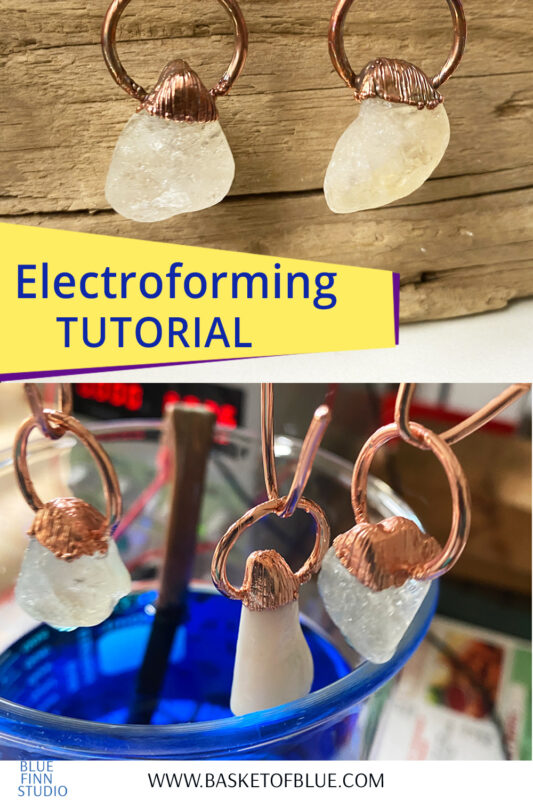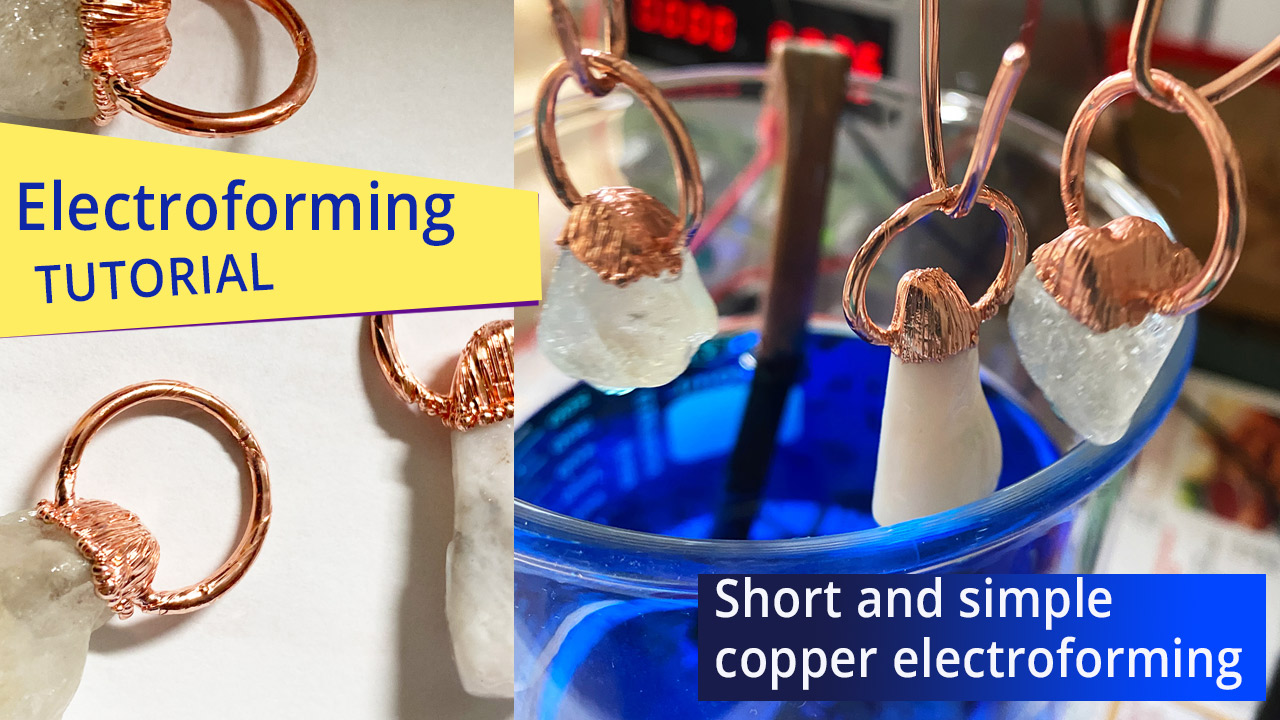Electroforming is the electrochemical deposition of metal (in this case, copper) onto an object. A layer of copper is formed using an electrolytic bath, it is essentially transported from solid copper to an object using electricity. The layer of copper forms slowly over many hours of time. An anode (copper) and a cathode (object) are immersed in an electrolytic bath that is made with a solution of metal salts (Copper Sulphate [CuSO4]). The layer of copper builds up through the direct current of electricity that is passed through the solution.
Electroforming Ingredients
We’re going to start with something simple so let’s electroform crystal pendants using semi-precious stones.
Essentials you need:
- Rectifier
- Glass beaker or jar
- Electroforming solution
- Copper (wire, sheet or tube for the solution and wire to hang your item in the solution)
- Conductive paint (graphite paint)
- Distilled water
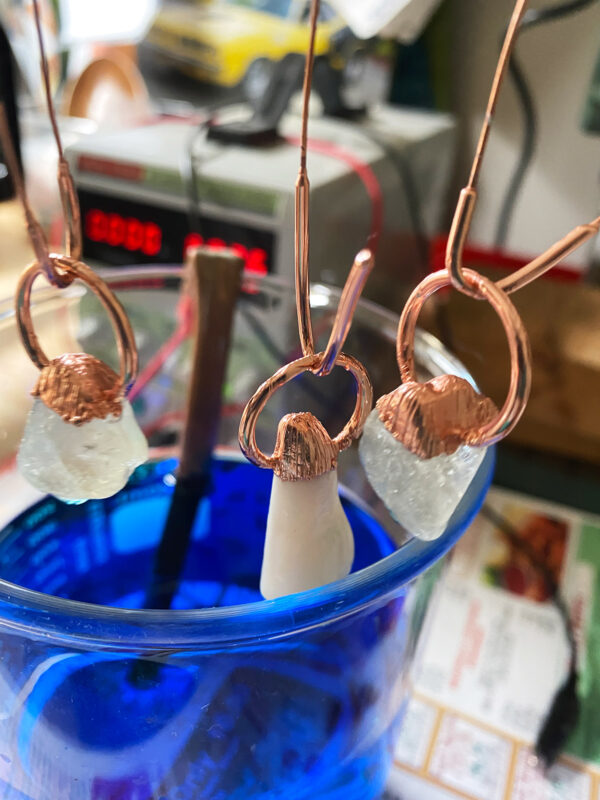
What kind of Stones can I Electroform?
There are very few limits when it comes to the items that can be electroformed. In this tutorial we are making jewelry so we are concentrating on gemstones. But, you can electroform almost anything – beach glass, shells, tree leaves, bark, common objects, etc. Porous materials will need to be sealed first, but other than that the sky is the limit.
Easiest stones to electroform are ones at least 6.5 – 7 in the hardness chart that won’t need protective coating. (see chart below) (Softer stones will need to be coated before electroforming and some choose to protect almost any stone.) I have electroformed many 6.5 hardness stones uncoated without damage. In this tutorial I am using Citrine, Amethyst, Chalcedony and Pink Opal. Other good potentials are for example Quartz, Labradorite and Prehnite. In this tutorial I am using stones that have holes (so they are “beads”), which makes it easier for a beginner to attach a bail.
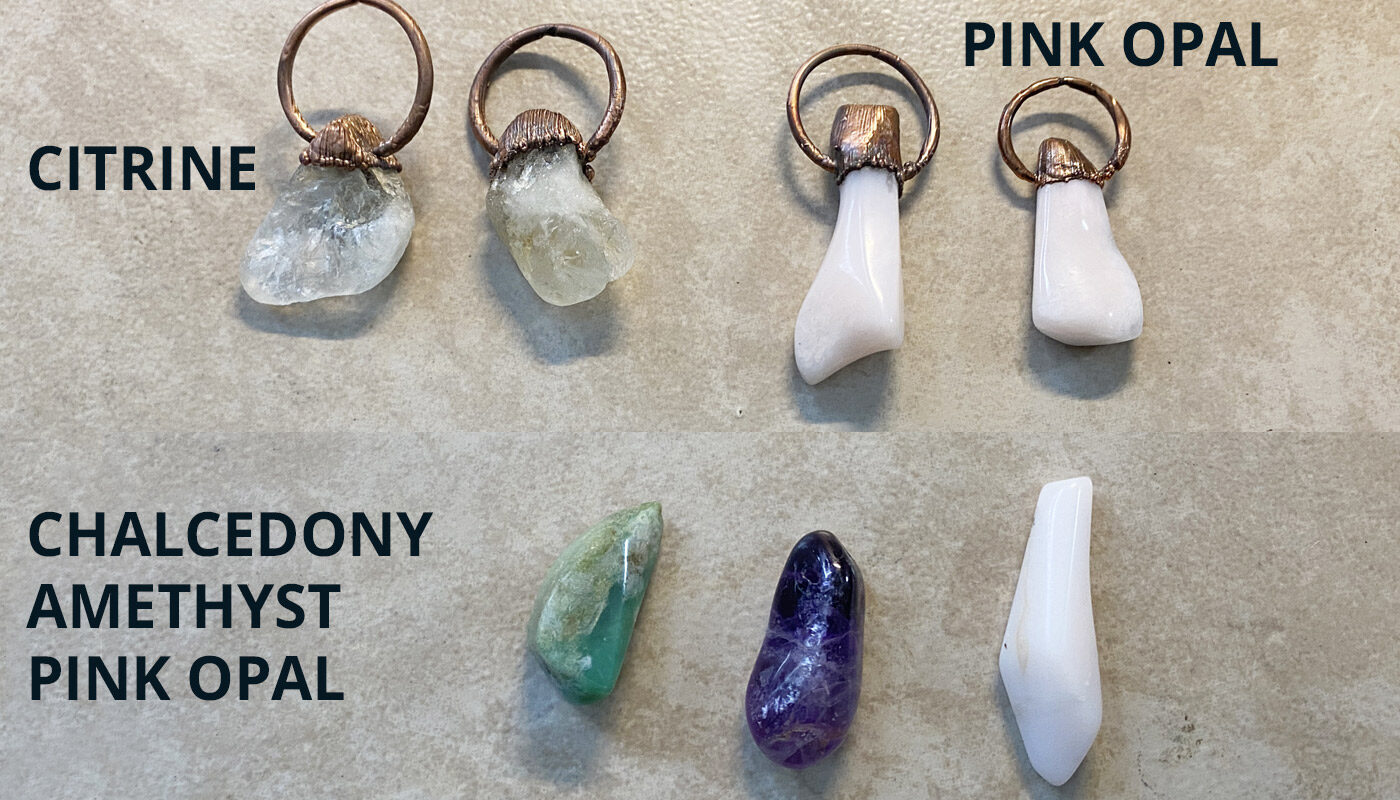
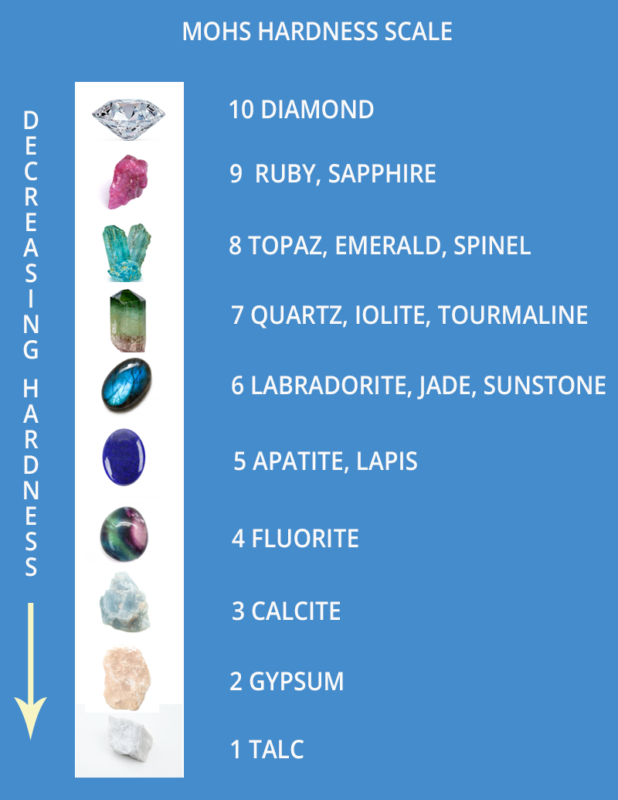
Preparing the Stones for Electroforming
There is only a couple of things you need to do before lowering the stones into the electrolytic bath.
- Make a bail (usually a metal wire loop)
- Paint with conductive paint (also called graphite paint)
- Seal with clear coat (if needed)
The easiest bail is a thin copper wire (e.g. 22 gauge) shaped round that you fit into the bead holes and secure with a little glue. Use a loop forming tool or a pencil to make a round shape the size you want. The copper will form onto the wire and make it thicker in the bath.
You can find conductive paint online or even make it yourself. It is essentially made out of graphite. The painted parts are where the copper is going layer onto in the bath. Thin the conductive paint with distilled water so it is easily paintable (for water based paint). Don’t thin too much or it can lose its power to grab the copper! You get the feel of the thickness, check the video. Paint onto the parts of the stone you want covered in copper. Include the area of the bead hole so your bail will be secure.
If needed, seal the stone with some type of clear coat or Modge Podge. I’ve heard people even using nail polish. I leave a little room between the conductive paint and the clear coat because the copper will form slightly over the painted area (especially if you want it thick.) If you are using a soft stone or other object that may get damaged by the solution cover it completely with your sealant.
Now let those stones dry and next day prepare your bath. It is important to let any sealant and conductive paint dry completely. (preferably 12- 24 hours) If they are not dry you may get cracks or other unwanted surface issues.
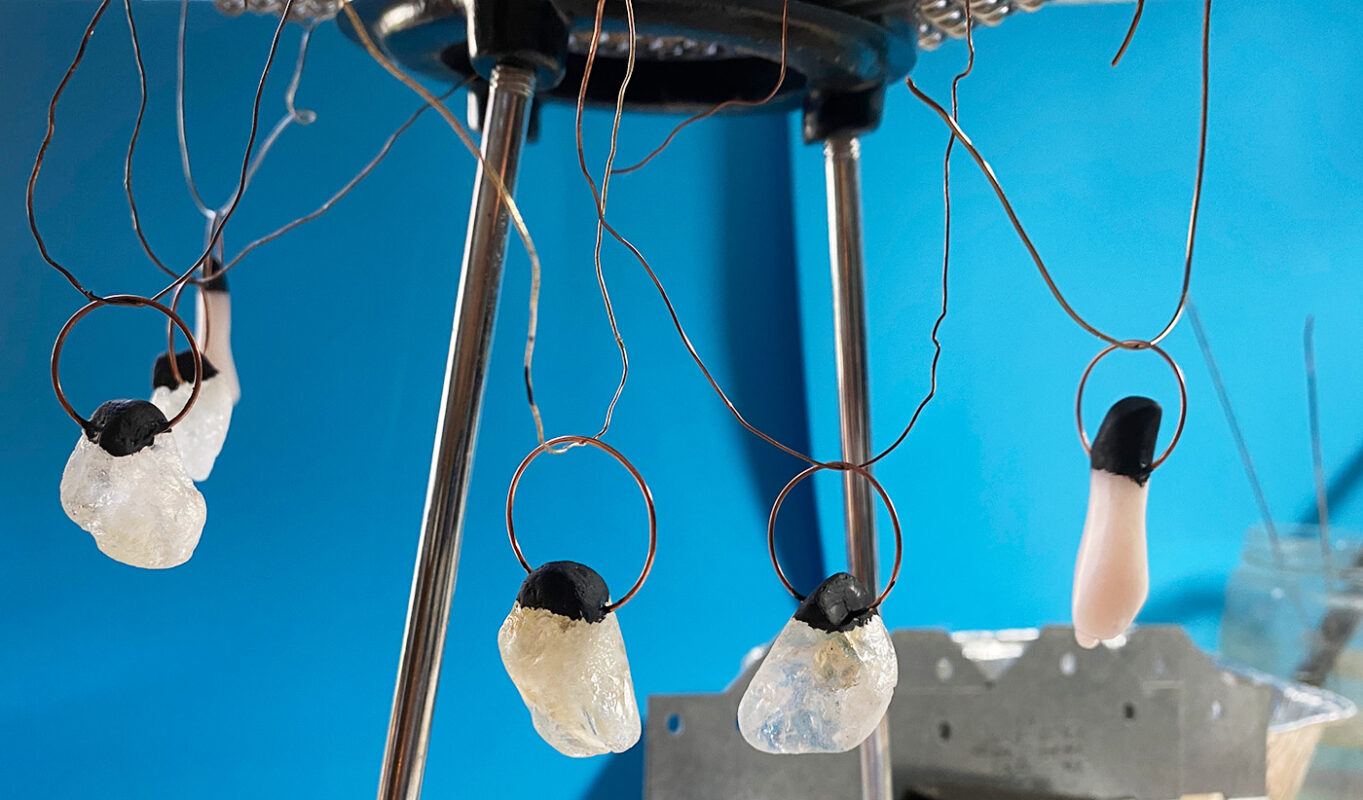
Copper Electroforming Bath
Electroforming Solution
Buy your electroforming solution from a reputable manufacturer (I get mine from Rio Grande). You can also make your own, especially if you end up making large baths or have several going at the same time.
Copper
You need copper in some solid form to put in your bath as the anode. (wire, tubing, sheet) I have used both 10 gauge wire and copper tubing. You want the copper to reach the full distance from the top of the solution to (almost) the bottom of the jar. People usually end up coiling the copper wire in a large coil around the inside of the beaker so that the piece being electroformed is hanging inside the coil. I have also just wrapped the wire tightly on itself on one side of the jar and it worked fine. It will generally wear off most in the middle, because that’s where you will suspend your pieces that are getting copper coating.
Suspension Bar and Wires
You need a piece of copper wire as the bar where you hang your items on and thinner copper wire for each individual stone. There are other ways to hang your pieces, but this is what I use (see more in the video). Keep in mind that you may need to sand your suspension bar periodically to keep it conductive (you will know when your rectifier numbers are not moving anymore). Also, it’s a good idea to not touch the suspension wire with bare hands. (fingers have oils, this can affect conductivity). Attach the red lead wire clip to the end of the anode that is sticking out of the beaker, and the black lead wire clip to the top of the cathode suspension bar. Do not let the clips directly touch the liquid solution.
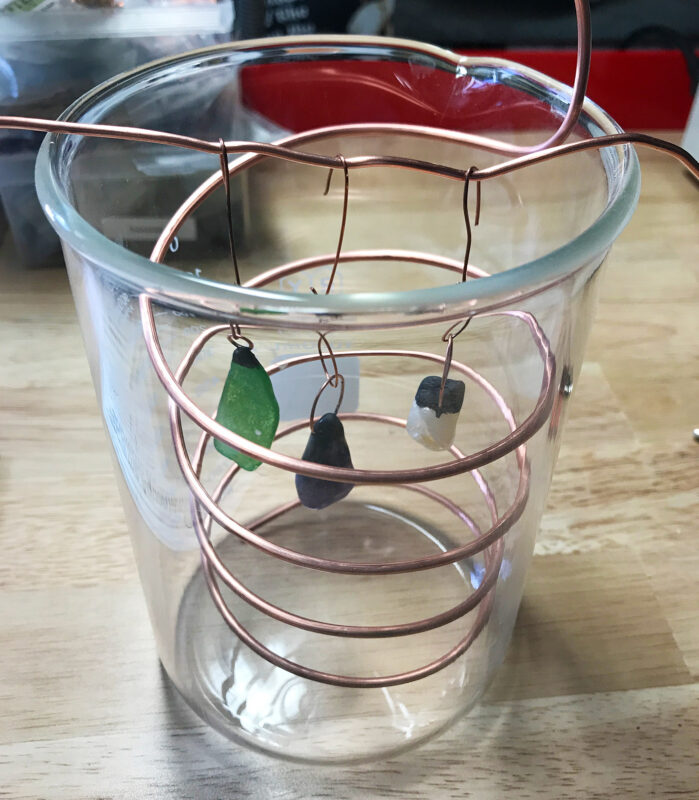
Setting Up the Rectifier
There are several ways to set your current with the fun knobs of the rectifier. Theoretically you are supposed to calculate the surface area of getting electroformed, then multiply that by…, etc. So far I have never calculated anything and I get satisfactory results. (see more info at the end of article) I use the method where the only knob you adjust is the fine voltage. Turn both current knobs all the way up, voltage all the way down and then only add fine voltage little at a time. I usually start with 0.1-0.3 voltage setting.
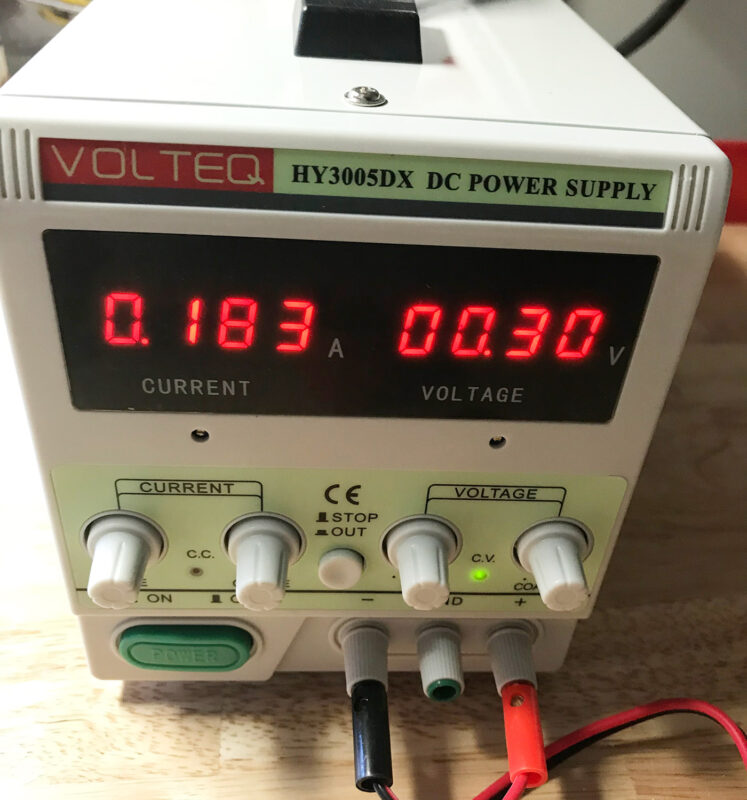
Final Checks Before the Electroforming Fun Starts
Measure your hanging wires so your stone(s) are hanging submerged but not touching the bottom. If you have several pieces in the bath they should not be touching each other. Lower them in, power your rectifier and watch the first copper layer build on! Depending on your settings and the result you want the process may take from hours to days. Keep on checking periodically and observe the level of liquid – if it has evaporated add distilled water to the bath. You may want the layers of copper to build slowly or fast, or you may be looking for certain surface effects. Keep checking the progress, pay attention to how the numbers on your rectifier are changing and adjust your settings accordingly. (see below for current calculation)
Potential Issues to Look for
The Rectifier numbers have stopped, everything is at 0
- Clean the suspension bar with sandpaper, it may have formed some oxidation and is not conducting
- The copper hooked to the anode is not one piece anymore (for example you used tubing and half of it is now laying on the bottom)
The electroforming liquid is cloudy
- Add brightener (a few drops usually does the trick)
- After a few uses you may want to filter your solution, especially if there is a lot of matter on the bottom. (You can use couple of layers of coffee filters.)
When Pieces are Finished Electroforming
Finishing Electroformed Jewelry
Smoothing and Finishing the Edges
Usually there is a bit of a roughness to some of the finished copper. Sometimes you even get real bumps! Run your finger around it to feel anything sharp and sand or buff those smooth.
Darkening with Patina
Liver of sulfur is the most commonly used darkening agent. You mix it with hot water, lower your pieces in until they are dark enough. Note to have ventilation, it is a very powerful smell! Neutralize solution with baking soda before discarding. You can then buff some highlights to your pieces by removing some of the patina.
Coloring with Patina
There are many patina or metal die products you can use if you desire other colors. Sometimes I grow natural patina on a piece to make it more interesting. Remember to seal your patina with some type of quality clear coat. (I use Protectaclear for all copper jewelry.)
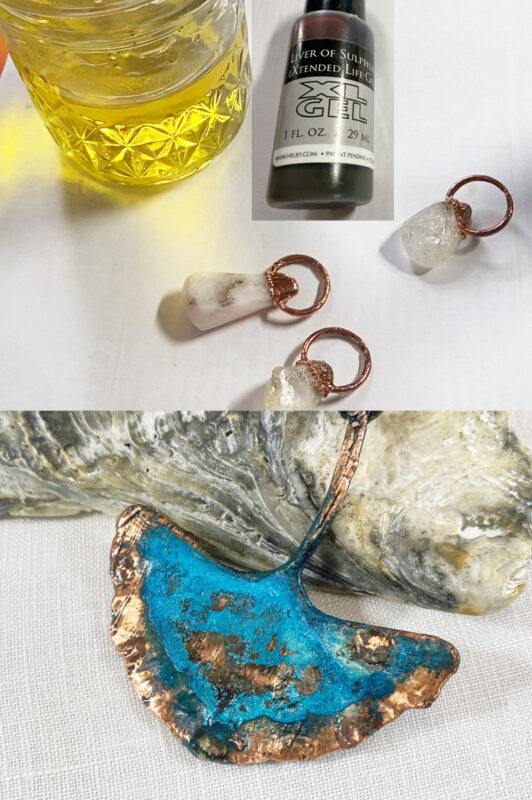
Calculating Surface Area and Current (Amps) for Electroforming
The surface area of the piece to be electroformed determines the current (amps) setting. The general idea is that you allow 0.1 amps per square inch of surface area. For example, if the surface area of the design measures 4 square inches, then the current should be set to 0.4 amps. But, this also depends of the type of electroformed copper surface you want, sometimes you may want high detail, sometimes low. (It is about how the small particles attach together.) For very fine detail some electroformers actually use the formula as 0.01 amps per inch. (pretty big difference) The results you want also affect the time needed to electroform, for fine detail (low amps) the process will take days, not hours. For quick results you may electroform the same piece in 6 hours (less detail). Surface area can be complicated, you can use an online calculator to try it out:
Surface area calculator
(https://www.calculator.net/surface-area-calculator.html)
Electroforming Solution
Rio Grande Electroforming Solution (on Rio Grande)
Enchanted Leaves (on Etsy)
Electroforming Kit (sold on Etsy by Enchanted Leaves)
Electroforming Kit (sold on Etsy by GlassDiversionsFrit)
Conductive Paint
Brightener
Midas Replenishing Brightener(Rio)
Gemstones
Rectifier
Metal Colorants
Want to learn how to create your own patina? See my Patina Tutorial
Electroforming Safety
Electroforming chemicals are hazardous and you should follow all common sense protective measures. Protect your eyes and skin, have good ventilation and do not inhale fumes. When pouring or filtering the liquid wear gloves, safety glasses, mask and apron. I recommend getting used to always wearing safety glasses when working on jewelry making. Get in the habit and it will become automatic and you won’t even notice the goggles anymore. There are some very comfortable and clear safety glasses on the market, my favorite ones are over the glasses NoCry safety glasses. Keep your vision and have fun!
PIN Image - perfect image to use on Pinterest!
